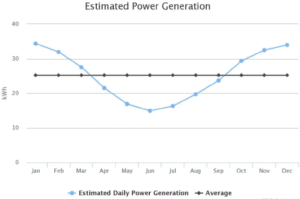Solar generation depends on several factors such as location, type of the rood and orientation, panel orientation, seasonal and daily weather, and lastly your system size. For this reason, we use averages for making it simple and CEC guidelines.
The CEC advises that in Queensland and New South Wales an average 6.6 kW solar system generates approximately 26.4 kWh energy on average daily. The average daily sun exposure taken into account is 4 hours, thus a simple way to estimate the output of a solar system is to multiply the system size by 4. On any given day, this figure can be extremely different, for example, during harsh weather conditions such as rainy /cloudy days. On the other hand, in Melbourne, an average of 24.4 kWh of energy is generated per day for a 6.6 kW solar system, because of less sun exposure in Victoria.
As an example, a 3kW system will generate approximately 12kWh of power per day. This may differ during summer and winter, which works well in Queensland and New South Wales households and businesses due to hot summer days. Here is the average daily output figure for a 6.6 kW solar system in Queensland.







